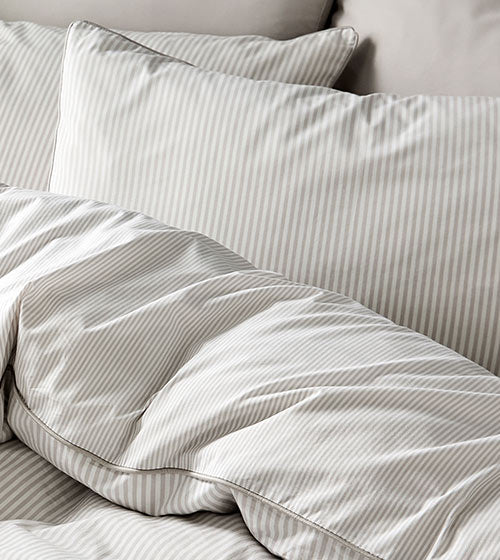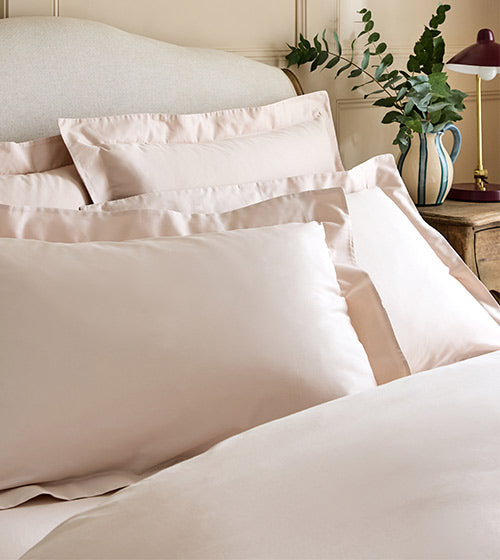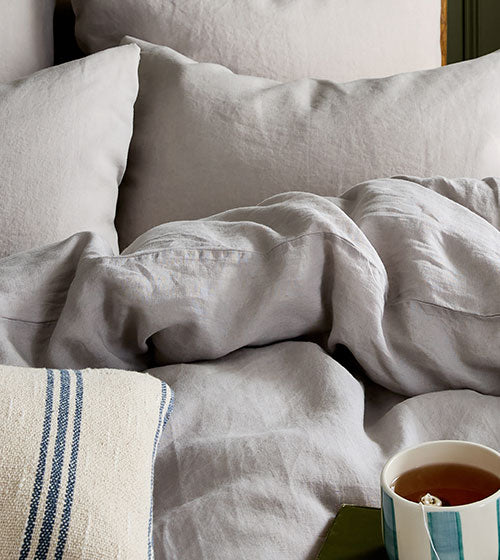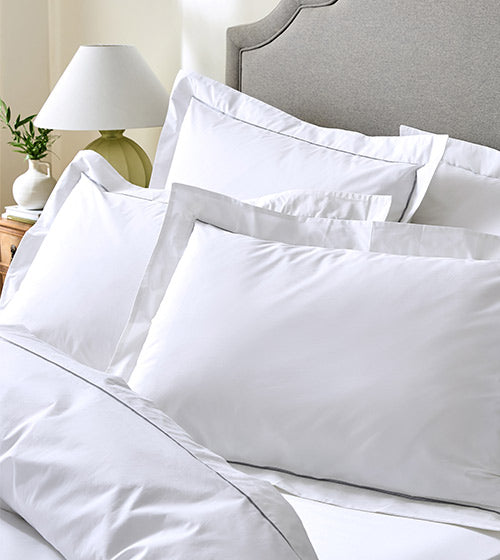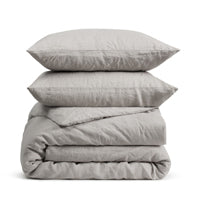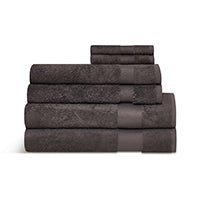
Ahhh, is there anything quite like sinking into fresh bedding after a long day? We don't think so, either!
Here's how to ensure your organic cotton sheets look their absolute best, while helping you sleep soundly year after year.
That is, of course, all while lowering your energy bills and reducing your carbon footprint—with these small but impactful tips. A little care and attention goes a (very) long way!
how often?
Generally speaking, washing once a fortnight should ensure you get that fresh sheet feeling night after night. Although, as there are so many different circumstances that determine this one, we can’t decide for you.
For example, if you’re a hot sleeper or struggle in the heat during the summer months, you may want to wash your bedding more regularly.
Disclaimer: Having two bedding sets means that you never have to be without nightly doses of much needed comfort on laundry days!

washing temperature
You don’t need a hot wash to get a really good clean, as your Dip & Doze organic cotton bedding fabric is able to wash easy. So, if the thought of germs makes you restless, remember that advanced detergents work wonders!
We suggest washing at 40°C, and maybe even 30°C with a non-bio detergent if your bedding isn’t too dirty.
All in the name of sustainability kudos, 30°C actually uses 38% less energy than washing at 40°C.
This being said, we recommend avoiding the quick wash cycle on your machine, as it won’t give the detergent enough time to work well.
fabric softener
If you’re using fabric softener, remember less really is more. You really don’t need much—just a pinch!
Organic cotton softens naturally over time. If you iron your sheets, however, a little softener will protect the fibres from the heat.

separation
White cotton easily picks up other colours. Keep your white sheets beautifully white by not washing them with any other colours. Learn more on our complete guide on how to keep your white bedding white!
Worried about your striped duvet covers? No need to toss and turn. Our stripes are yard dyed, meaning they’re colour fast and won’t leak. Just be sure to wash with other light colours to be safe from damage.

button it up
Avoid a tangled bundle of sheets and pillowcases at the end of your cycle by always buttoning up your duvet cover beforehand.
Our natural button closures are perfect for staying fastened around the drum, so your bedding can get the best clean.
Be sure not to mix your load with items that might snag your bedding like zippers and bras, though, as your bedding might not respond well to these.
give them space
Ensure you don’t fill your machine over three quarters full so the detergent and softener can effectively rinse out, helping prevent prominent creases in your organic cotton bedding.
top tips for drying
Another easy breezy way to avoid creases setting into your sheets is by removing them from the washing machine as quickly as possible.
We advise trying to avoid the tumble dryer whenever possible. However, if you need a helping hand during the winter months, try to do so on a low heat setting.
Another little tip if you’re using your tumble dryer is to remove your bedding while it’s still warm and just before it’s completely dry. Do this last bit of drying naturally (hang them over a banister, put them on the line if the sun's shining or lay them flat on your bed) – this is like doing a touch of ironing without the hassle!
And don’t be shy to use your washing line even if it’s not summer. All you need is a slight breeze on a dry day.
to iron or not to iron
Oh, the mundane art of ironing... Do you love it or loathe it? If it’s the latter, we get you. It can be time-consuming.
And we’ll be the first to say it—we find there’s something wonderfully soothing about sinking into the natural wrinkles of bedding. However, if you do find comfort in immaculate sheets, it’s perfectly safe to iron your organic cotton bedding.
Top tip for keeping your Dip & Doze as neat as can be? Iron your bedding while it’s still a little damp (but not wet) using the cotton heat setting. This will make achieving perfectly crisp bed linen so much easier.
We find adding a glass of vino makes time spent ironing go by so much quicker, too!
breakfast in bed mishaps
Act fast! You may have just climbed back into bed with your hot tea on a Sunday morning and the last thing you want to do is put a wash on, but this is our top tip for rescuing your sheets.

Apply stain remover directly to the stain (ensuring it doesn’t contain any bleach if you have coloured bedding).
If you don’t have any stain remover to hand, you can spot clean by adding a little laundry detergent or washing up liquid to the stain.
And there you have it. Love your bedding and it’ll love you back for years to come, remaining tip top quality—something that is hard to find in bed linen nowadays.

While high-quality linen and cotton bedding are both equally beautiful options when it comes to long-lasting, slow-living staples that turn your house into a home—each fabric is made from very different plant fibres. Where cotton uses cotton plant fibres (long-staple), linen uses flax plant fibres.
So, let’s unpack just what treatment our linen prefers.

A beautiful, expertly sourced, and naturally produced fabric, our linen deserves to be cared for and loved—but doesn’t require heaps of time and space in your laundry room for you to reap its benefits.
When cared for, it will get softer with every wash and keep you sleeping as sumptuously as can be.
machine washing
First and foremost, ensure you don’t fill your machine over three quarters full, to allow your linen bedding to properly soak, while your detergent and softener can be effectively rinsed out.
Another top tip? Just like we advise with our organic cotton bedding, button up your bedding and avoid mixing with snag-prone items in the washer (such as zips and bras) to prevent your sheets from getting tangled and damaged.

Also, avoid selecting a quick wash cycle on your machine as it won’t give your detergent enough time to work well. For the safest option, wash your natural linen bedding with warm water (30°C) to maintain the quality of the beautiful loose weave.
And, although we know most of you love the laid-back, relaxed look of linen, a lighter cinched appearance can be achieved by using a lower spin or a permanent-press cycle.
This is, whilst avoiding fabric softener which can interrupt the natural softening that occurs over time with our natural linen bedding.
air drying
When the weather and your schedule allow, opt for air drying your bedding on a clothesline. Be sure to smooth the hems and edges of your bedding as you hang it up, to help it hold its shape.
machine drying
We always advise trying to avoid the tumble dryer whenever possible.
However, if you need a helping hand during the winter months or you don’t have access to an outdoor space, try to do so on a medium to low heat, timed dry setting.
treating stains
Act fast! You may have just climbed back into bed with your hot tea on a Sunday morning and the last thing you want to do is put a wash on, but this is our top tip for rescuing your sheets. As long as you attend to any mishaps instantly, you can rescue your sheets quickly and easily.

Firstly, dampen the area before you begin trying to remove the stain. After testing your stain remover on an inside seam or hem of the same bedding set to ensure it doesn’t cause discolouration (if you haven’t previously done already), apply your stain remover directly to the mark.
Alternatively, if you don’t have any stain remover to hand, you can spot-clean by carefully adding a little laundry detergent or washing up liquid to the stain. You can also remove most stains by applying a tiny amount of your regular laundry detergent directly to the stained area—working it in with your fingers or a soft bristled brush as you would a stain remover product. If you use this method, allow the detergent to work for at least 15 minutes on your natural linen bedding before machine washing it as usual.
post-drying
When it comes to post-wash maintenance, our natural linen takes the win for most-easy-to-care-for bedding.
There’s no need to iron your linen sheets—simply fall in love with its inherent wrinkles that give it it’s ever so charming, antique linen feel.
And, by having two or more natural linen bedding sets to hand, you never have to be without your luxury night-time lapse of natural linen leisure.


We all want to keep our plush and precious bedroom comforts in tip top condition. Whether it’s natural linen or organic cotton bed sheets, the right care is instrumental to preserving their quality.
Here are some ideas for bedding storage that will keep your bedding in tip-top shape.
keep the moisture at bay
Mould and mildew can ruin your bedding, so it’s important to keep moisture at bay.
Choose a bedding storage space that’s cool, airy, dry, and spacious. This will help prevent moisture build-up and keep your bedding fresh and clean.
Before storing your bedding, make sure it’s completely dry. Any moisture left can lead to mould and mildew growth, which can ruin your bedding. Once dry, here’s how to store it in suitable conditions to prevent moisture build-up.
choose suitable storage containers
Wire baskets are a great option for bedding storage. They allow proper airflow, which is essential for natural fabrics to breathe.

keep everything organised
Organising your bed sheet storage is key to keeping it in good condition. Try repurposing an under-shelf organiser in your linen closet to hold your bedding separate to other household items such as towels.
Use our complimentary organic cotton drawstring bags for protection against bugs and dust. Made from offcuts of our organic cotton bedding, these bags are light enough to still allow proper airflow. They also have handy sewn-in size labels so you can easily find the bedding you’re looking for.

By following these storage tips, you can keep your bedding in top condition and create a calming cocoon in your bedroom.

We made our bath linens from the same finest quality organic and Fairtrade cotton as our bedding, so you can extend that blissful feeling as you step out of the bath or shower.
Here are our secrets to keeping your hardworking bathroom essentials at their comforting, absorbent best for longer…
washing temperature
We know it can be tempting to constantly wash your bath linen at high temperatures considering the germs they can harbour. But this doesn’t help keep them fluffy and supple!
As high temperatures strip the natural fibres of their softness over time, we suggest washing between 30°C to 40°C. Paired with a good detergent, dirt and natural body oils will be removed effectively. Good for your towels, good for our planet, good for your energy bills.

detergents we recommend using
Firstly, go easy with the detergent! Many of us are guilty of using too much in our washes when we want to give our towels a really good old clean.
However, using too much simply makes it much harder to remove during the rinse cycle. This then accumulates over time, leaving residue on your towels that causes them to stiffen.
Although, it isn’t an exact science. For example, you’ll need a little more detergent if you live in more of a hard water area than a soft water area. You may also need a little more for a particularly dirty load.
As a general rule, we recommend to follow the manufacturers guidelines, then, once you’re used to a particular brand, you can adjust according to your situation.
It’s not just the amount of laundry detergent you use, but the type can help too. Harsh detergents can permanently damage the natural fibres in cotton bath linen.
We always recommend using gentler detergent and considering non-bio options to reduce skin irritation.
Avoid fabric conditioner, or if it’s a must for you, go very easy. You really don’t need much! Fabric conditioners actually leave a waxy residue on your bath linen over time. This coating affects their drying performance by preventing them from absorbing as much water. Not a quality you’re probably looking for in a towel!
give them space
On that note, ensure you don’t fill your machine over three quarters full. If there are too many towels in the drum, the detergent and conditioner can’t be effectively rinsed out, adding to the problem of stiff towels.
Unfortunately, your clothes and towels don’t love each other as much as you love them. Wash towels alone as the heavy weight can rub against your clothes and lead to pilling. Items with zips, hooks or trims can also snag your towels. In the event of a snagged loop avoid pulling. Simply snip off with scissors instead.

top tips for drying
If the wonderfully unpredictable weather is preventing you from line drying outdoors, try to avoid putting on top of radiators as too much heat can cause stiff, scratchy fibres. Instead, use an airer in an airing cupboard or nearby to a radiator. Rotating them regularly can help them dry quicker.
A windy day is perfect for agitating the fibres in your bath linen, stopping them from sticking together and resulting in softer towels. If it’s a still day or you’re drying indoors, shake your towels out after washing and again after drying to fluff them up.
If you need to use a tumble dryer, ensure you don’t over dry and strip them of all moisture (a main cause of crusty towels). Use a low temperature and a setting that doesn’t completely dry out your towels.
how often to wash your towel
Not to turn this into a distasteful science lesson throwback, but the top 20 layers of our skin are made up of naturally developing cells such as sweat, salt, sebum and other body soils that accumulate. Some of which scrub off in the shower, but many of which end up on our bath towel. And these microscopic germs thrive in steamy bathrooms, which can cause bacteria build up.
So, how can we ensure we’re experiencing a truly clean and warming embrace from our towel after each shower?

under normal circumstances…
It’s recommended that a common bath towel be used by 1 person 3 to 4 times between each wash (given that they’re hung to fully dry between each use). Hand towels, on the other hand, should be replaced every 2 days (given that they’re used continuously throughout the day).
under different circumstances…
Of course, the number of times a used towel should be washed will always vary from home to home. For instance, any towel used by those of us with sensitive skin or eczema may want to launder our towel after every use.
the ultimate solution: invest in longevity
The good news is that you don’t have to spend money on constantly replacing your towels when they wear after so many washes. With quality-assured towels: just treat them right and they’ll return the favour for many years! Using organic cotton towels makes for a much softer, more absorbent, and more luxurious experience that will allow you to effectively dry off. What’s more—they save you a lot of money in the long run!
And there you have it. Love your towels and they’ll love you back for years to come. Shop organic & Fairtrade, lovingly made bath linen.

Wash your beautiful Dip & Doze loungewear at 30°C or by hand, using a gentle detergent (and of course, never bleach!). Temperatures higher than this can stiffen and shrink the fibres.
For the best cleaning power and garment care, wash your garments inside out and be sure not to overfill your machine.
If it’s just dirty in a teeny area, why not spot clean instead?
Air dry by lying flat or hanging on the line whenever possible.
We love to embrace the crumple of un-ironed hemp. It’s the kind of beauty that sings to us. A beautifully lived in look with traces of life. BUT if you like things a little neater and just so, iron on a low—medium heat.
The more you love your loungewear, the more it will love you back, so iron whilst damp or by placing a towel on top.

You’ve consciously chosen or shown interest in organic cotton bedding or natural linen bedding, so kudos to you!
But why stop there? While conventional detergents are some of the most toxic, fragranced, dirty cleaning products out there, there are lots of healthy alternatives that are sure to wash your bedding well.
We recommend gentler, non-bio detergents. These aren’t only kinder to your bedding, but also do wonders for your skin. After all, it’s the detergent that plays the biggest role in killing germs—not the water temperature.
Many of us are guilty of over-using detergent in our washes when we want to give our favourite go-to bedding a really good clean. And although your Dip & Doze bedding washes well, using too much detergent actually makes it harder to remove during the rinse cycle. It isn’t an exact science.
For example, you’ll need a little more detergent if you live in a hard water area than a soft water area. You may also need a little more for a particularly dirty load.
But as a general rule, we recommend following the manufacturer's guidelines, until you’re used to a particular brand. Then, you can adjust accordingly.


Ahhh, is there anything quite like sinking into fresh bedding after a long day? We don't think so, either!
Here's how to ensure your organic cotton sheets look their absolute best, while helping you sleep soundly year after year.
That is, of course, all while lowering your energy bills and reducing your carbon footprint—with these small but impactful tips. A little care and attention goes a (very) long way!
how often?
Generally speaking, washing once a fortnight should ensure you get that fresh sheet feeling night after night. Although, as there are so many different circumstances that determine this one, we can’t decide for you.
For example, if you’re a hot sleeper or struggle in the heat during the summer months, you may want to wash your bedding more regularly.
Disclaimer: Having two bedding sets means that you never have to be without nightly doses of much needed comfort on laundry days!

washing temperature
You don’t need a hot wash to get a really good clean, as your Dip & Doze organic cotton bedding fabric is able to wash easy. So, if the thought of germs makes you restless, remember that advanced detergents work wonders!
We suggest washing at 40°C, and maybe even 30°C with a non-bio detergent if your bedding isn’t too dirty.
All in the name of sustainability kudos, 30°C actually uses 38% less energy than washing at 40°C.
This being said, we recommend avoiding the quick wash cycle on your machine, as it won’t give the detergent enough time to work well.
fabric softener
If you’re using fabric softener, remember less really is more. You really don’t need much—just a pinch!
Organic cotton softens naturally over time. If you iron your sheets, however, a little softener will protect the fibres from the heat.

separation
White cotton easily picks up other colours. Keep your white sheets beautifully white by not washing them with any other colours. Learn more on our complete guide on how to keep your white bedding white!
Worried about your striped duvet covers? No need to toss and turn. Our stripes are yard dyed, meaning they’re colour fast and won’t leak. Just be sure to wash with other light colours to be safe from damage.

button it up
Avoid a tangled bundle of sheets and pillowcases at the end of your cycle by always buttoning up your duvet cover beforehand.
Our natural button closures are perfect for staying fastened around the drum, so your bedding can get the best clean.
Be sure not to mix your load with items that might snag your bedding like zippers and bras, though, as your bedding might not respond well to these.
give them space
Ensure you don’t fill your machine over three quarters full so the detergent and softener can effectively rinse out, helping prevent prominent creases in your organic cotton bedding.
top tips for drying
Another easy breezy way to avoid creases setting into your sheets is by removing them from the washing machine as quickly as possible.
We advise trying to avoid the tumble dryer whenever possible. However, if you need a helping hand during the winter months, try to do so on a low heat setting.
Another little tip if you’re using your tumble dryer is to remove your bedding while it’s still warm and just before it’s completely dry. Do this last bit of drying naturally (hang them over a banister, put them on the line if the sun's shining or lay them flat on your bed) – this is like doing a touch of ironing without the hassle!
And don’t be shy to use your washing line even if it’s not summer. All you need is a slight breeze on a dry day.
to iron or not to iron
Oh, the mundane art of ironing... Do you love it or loathe it? If it’s the latter, we get you. It can be time-consuming.
And we’ll be the first to say it—we find there’s something wonderfully soothing about sinking into the natural wrinkles of bedding. However, if you do find comfort in immaculate sheets, it’s perfectly safe to iron your organic cotton bedding.
Top tip for keeping your Dip & Doze as neat as can be? Iron your bedding while it’s still a little damp (but not wet) using the cotton heat setting. This will make achieving perfectly crisp bed linen so much easier.
We find adding a glass of vino makes time spent ironing go by so much quicker, too!
breakfast in bed mishaps
Act fast! You may have just climbed back into bed with your hot tea on a Sunday morning and the last thing you want to do is put a wash on, but this is our top tip for rescuing your sheets.

Apply stain remover directly to the stain (ensuring it doesn’t contain any bleach if you have coloured bedding).
If you don’t have any stain remover to hand, you can spot clean by adding a little laundry detergent or washing up liquid to the stain.
And there you have it. Love your bedding and it’ll love you back for years to come, remaining tip top quality—something that is hard to find in bed linen nowadays.

While high-quality linen and cotton bedding are both equally beautiful options when it comes to long-lasting, slow-living staples that turn your house into a home—each fabric is made from very different plant fibres. Where cotton uses cotton plant fibres (long-staple), linen uses flax plant fibres.
So, let’s unpack just what treatment our linen prefers.

A beautiful, expertly sourced, and naturally produced fabric, our linen deserves to be cared for and loved—but doesn’t require heaps of time and space in your laundry room for you to reap its benefits.
When cared for, it will get softer with every wash and keep you sleeping as sumptuously as can be.
machine washing
First and foremost, ensure you don’t fill your machine over three quarters full, to allow your linen bedding to properly soak, while your detergent and softener can be effectively rinsed out.
Another top tip? Just like we advise with our organic cotton bedding, button up your bedding and avoid mixing with snag-prone items in the washer (such as zips and bras) to prevent your sheets from getting tangled and damaged.

Also, avoid selecting a quick wash cycle on your machine as it won’t give your detergent enough time to work well. For the safest option, wash your natural linen bedding with warm water (30°C) to maintain the quality of the beautiful loose weave.
And, although we know most of you love the laid-back, relaxed look of linen, a lighter cinched appearance can be achieved by using a lower spin or a permanent-press cycle.
This is, whilst avoiding fabric softener which can interrupt the natural softening that occurs over time with our natural linen bedding.
air drying
When the weather and your schedule allow, opt for air drying your bedding on a clothesline. Be sure to smooth the hems and edges of your bedding as you hang it up, to help it hold its shape.
machine drying
We always advise trying to avoid the tumble dryer whenever possible.
However, if you need a helping hand during the winter months or you don’t have access to an outdoor space, try to do so on a medium to low heat, timed dry setting.
treating stains
Act fast! You may have just climbed back into bed with your hot tea on a Sunday morning and the last thing you want to do is put a wash on, but this is our top tip for rescuing your sheets. As long as you attend to any mishaps instantly, you can rescue your sheets quickly and easily.

Firstly, dampen the area before you begin trying to remove the stain. After testing your stain remover on an inside seam or hem of the same bedding set to ensure it doesn’t cause discolouration (if you haven’t previously done already), apply your stain remover directly to the mark.
Alternatively, if you don’t have any stain remover to hand, you can spot-clean by carefully adding a little laundry detergent or washing up liquid to the stain. You can also remove most stains by applying a tiny amount of your regular laundry detergent directly to the stained area—working it in with your fingers or a soft bristled brush as you would a stain remover product. If you use this method, allow the detergent to work for at least 15 minutes on your natural linen bedding before machine washing it as usual.
post-drying
When it comes to post-wash maintenance, our natural linen takes the win for most-easy-to-care-for bedding.
There’s no need to iron your linen sheets—simply fall in love with its inherent wrinkles that give it it’s ever so charming, antique linen feel.
And, by having two or more natural linen bedding sets to hand, you never have to be without your luxury night-time lapse of natural linen leisure.


We all want to keep our plush and precious bedroom comforts in tip top condition. Whether it’s natural linen or organic cotton bed sheets, the right care is instrumental to preserving their quality.
Here are some ideas for bedding storage that will keep your bedding in tip-top shape.
keep the moisture at bay
Mould and mildew can ruin your bedding, so it’s important to keep moisture at bay.
Choose a bedding storage space that’s cool, airy, dry, and spacious. This will help prevent moisture build-up and keep your bedding fresh and clean.
Before storing your bedding, make sure it’s completely dry. Any moisture left can lead to mould and mildew growth, which can ruin your bedding. Once dry, here’s how to store it in suitable conditions to prevent moisture build-up.
choose suitable storage containers
Wire baskets are a great option for bedding storage. They allow proper airflow, which is essential for natural fabrics to breathe.

keep everything organised
Organising your bed sheet storage is key to keeping it in good condition. Try repurposing an under-shelf organiser in your linen closet to hold your bedding separate to other household items such as towels.
Use our complimentary organic cotton drawstring bags for protection against bugs and dust. Made from offcuts of our organic cotton bedding, these bags are light enough to still allow proper airflow. They also have handy sewn-in size labels so you can easily find the bedding you’re looking for.

By following these storage tips, you can keep your bedding in top condition and create a calming cocoon in your bedroom.

We made our bath linens from the same finest quality organic and Fairtrade cotton as our bedding, so you can extend that blissful feeling as you step out of the bath or shower.
Here are our secrets to keeping your hardworking bathroom essentials at their comforting, absorbent best for longer…
washing temperature
We know it can be tempting to constantly wash your bath linen at high temperatures considering the germs they can harbour. But this doesn’t help keep them fluffy and supple!
As high temperatures strip the natural fibres of their softness over time, we suggest washing between 30°C to 40°C. Paired with a good detergent, dirt and natural body oils will be removed effectively. Good for your towels, good for our planet, good for your energy bills.

detergents we recommend using
Firstly, go easy with the detergent! Many of us are guilty of using too much in our washes when we want to give our towels a really good old clean.
However, using too much simply makes it much harder to remove during the rinse cycle. This then accumulates over time, leaving residue on your towels that causes them to stiffen.
Although, it isn’t an exact science. For example, you’ll need a little more detergent if you live in more of a hard water area than a soft water area. You may also need a little more for a particularly dirty load.
As a general rule, we recommend to follow the manufacturers guidelines, then, once you’re used to a particular brand, you can adjust according to your situation.
It’s not just the amount of laundry detergent you use, but the type can help too. Harsh detergents can permanently damage the natural fibres in cotton bath linen.
We always recommend using gentler detergent and considering non-bio options to reduce skin irritation.
Avoid fabric conditioner, or if it’s a must for you, go very easy. You really don’t need much! Fabric conditioners actually leave a waxy residue on your bath linen over time. This coating affects their drying performance by preventing them from absorbing as much water. Not a quality you’re probably looking for in a towel!
give them space
On that note, ensure you don’t fill your machine over three quarters full. If there are too many towels in the drum, the detergent and conditioner can’t be effectively rinsed out, adding to the problem of stiff towels.
Unfortunately, your clothes and towels don’t love each other as much as you love them. Wash towels alone as the heavy weight can rub against your clothes and lead to pilling. Items with zips, hooks or trims can also snag your towels. In the event of a snagged loop avoid pulling. Simply snip off with scissors instead.

top tips for drying
If the wonderfully unpredictable weather is preventing you from line drying outdoors, try to avoid putting on top of radiators as too much heat can cause stiff, scratchy fibres. Instead, use an airer in an airing cupboard or nearby to a radiator. Rotating them regularly can help them dry quicker.
A windy day is perfect for agitating the fibres in your bath linen, stopping them from sticking together and resulting in softer towels. If it’s a still day or you’re drying indoors, shake your towels out after washing and again after drying to fluff them up.
If you need to use a tumble dryer, ensure you don’t over dry and strip them of all moisture (a main cause of crusty towels). Use a low temperature and a setting that doesn’t completely dry out your towels.
how often to wash your towel
Not to turn this into a distasteful science lesson throwback, but the top 20 layers of our skin are made up of naturally developing cells such as sweat, salt, sebum and other body soils that accumulate. Some of which scrub off in the shower, but many of which end up on our bath towel. And these microscopic germs thrive in steamy bathrooms, which can cause bacteria build up.
So, how can we ensure we’re experiencing a truly clean and warming embrace from our towel after each shower?

top tips for drying
If the wonderfully unpredictable weather is preventing you from line drying outdoors, try to avoid putting on top of radiators as too much heat can cause stiff, scratchy fibres. Instead, use an airer in an airing cupboard or nearby to a radiator. Rotating them regularly can help them dry quicker.
A windy day is perfect for agitating the fibres in your bath linen, stopping them from sticking together and resulting in softer towels. If it’s a still day or you’re drying indoors, shake your towels out after washing and again after drying to fluff them up.
If you need to use a tumble dryer, ensure you don’t over dry and strip them of all moisture (a main cause of crusty towels). Use a low temperature and a setting that doesn’t completely dry out your towels.
how often to wash your towel
Not to turn this into a distasteful science lesson throwback, but the top 20 layers of our skin are made up of naturally developing cells such as sweat, salt, sebum and other body soils that accumulate. Some of which scrub off in the shower, but many of which end up on our bath towel. And these microscopic germs thrive in steamy bathrooms, which can cause bacteria build up.
So, how can we ensure we’re experiencing a truly clean and warming embrace from our towel after each shower?

Wash your beautiful Dip & Doze loungewear at 30°C or by hand, using a gentle detergent (and of course, never bleach!). Temperatures higher than this can stiffen and shrink the fibres.
For the best cleaning power and garment care, wash your garments inside out and be sure not to overfill your machine.
If it’s just dirty in a teeny area, why not spot clean instead?
Air dry by lying flat or hanging on the line whenever possible.
We love to embrace the crumple of un-ironed hemp. It’s the kind of beauty that sings to us. A beautifully lived in look with traces of life. BUT if you like things a little neater and just so, iron on a low—medium heat.
The more you love your loungewear, the more it will love you back, so iron whilst damp or by placing a towel on top.

You’ve consciously chosen or shown interest in organic cotton bedding or natural linen bedding, so kudos to you!
But why stop there? While conventional detergents are some of the most toxic, fragranced, dirty cleaning products out there, there are lots of healthy alternatives that are sure to wash your bedding well.
We recommend gentler, non-bio detergents. These aren’t only kinder to your bedding, but also do wonders for your skin. After all, it’s the detergent that plays the biggest role in killing germs—not the water temperature.
Many of us are guilty of over-using detergent in our washes when we want to give our favourite go-to bedding a really good clean. And although your Dip & Doze bedding washes well, using too much detergent actually makes it harder to remove during the rinse cycle. It isn’t an exact science.
For example, you’ll need a little more detergent if you live in a hard water area than a soft water area. You may also need a little more for a particularly dirty load.
But as a general rule, we recommend following the manufacturer's guidelines, until you’re used to a particular brand. Then, you can adjust accordingly.

